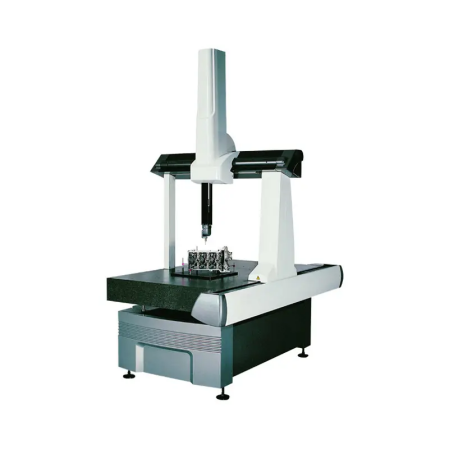Three coordinate measuring machines are mainly used in industrial metrology applications such as automotive parts industry, injection mold industry, 3C electronics industry, cutting and tool industry, precision machining industry, etc., including product inspection and fixture inspection. Using computer control, the measurement is very fast and has automated measurement functions, which can greatly improve work efficiency and save labor costs. The output data is very reliable, and the data processing and analysis functions are also very powerful, which can accurately analyze the shape and size characteristics of different workpieces, providing a reliable data foundation for the manufacturing process.
It can be used in conjunction with automation equipment such as robots to achieve fully automated measurement and detection, with more complete process flow and improved production efficiency. Not only can it be used to measure mechanical manufacturing parts, but it can also be used to measure complex surfaces, radar antennas, spacecraft models, etc., with a wide range of applications. Compared with traditional methods, the coordinate measuring instrument does not require the production of measurement templates, and can directly measure the workpiece. It can also perform real-time measurement during the manufacturing process, greatly saving time and cost. In summary, the application prospects of coordinate measuring instruments in the manufacturing industry are very broad. Its reliable data, fully automated application range, and time-saving cost advantages have been recognized and favored by the vast industrial field.
A coordinate measuring instrument is a high-precision device that can measure various parameters of objects in three-dimensional space. What are its advantages compared to other measurement methods? The coordinate measuring instrument adopts high-precision sensors and measurement systems, which can achieve sub micron level accuracy. Compared to traditional measurement methods, it is faster and can complete measurement tasks in a short period of time. It has the advantage of high degree of automation, which can automate tasks and reduce manual intervention. The use of reliable sensors and systems can ensure the accuracy and reliability of the results. Can adapt to objects of various shapes and sizes and complete complex tasks.
In summary, coordinate measuring instruments have the advantages of high precision, fast measurement, high degree of automation, high reliability and adaptability, and are therefore widely used in various industrial fields.
Methods to reduce needle measurement errors in coordinate measuring machines:
(1) Advance detection and calibration
When calibrating the measuring needle of a coordinate measuring machine, a ball axis that meets the specifications should be selected for contact measurement to ensure the accuracy of the needle calibration. Pay attention to the diameter of the measuring needle after calibration and the appearance error during calibration. If there are significant changes, it is necessary to find the reason. When calibrating multiple probe positions, in addition to observing the above results, the calibrated measuring needles at each position should also be used to measure the standard ball.
(2) Timely replacement of measuring needles
Due to the fact that the length of the measuring needle in a coordinate measuring machine is an important parameter for automatic calibration of the measuring head, if the calibration error is automatically changed, it will cause abnormal collision of the measuring needle. In mild cases, it may damage the measuring needle, and in severe cases, it may cause damage to the measuring head (sensor). Be able to initialize the coordinate system of the measuring needle holder and then re establish it. If the measuring head is too heavy and loses balance, try adding a counterweight block in the opposite direction of the measuring head to handle it.
(3) Standardized ball diameter
It is necessary to input the theoretical diameter of the standard ball correctly. Based on the principle of measuring needle calibration, it can be seen that the theoretical diameter value of the standard ball will directly affect the sphericity error of measuring needle calibration. Offline programming, virtual measurement, and position tolerance evaluation are all methods that can help improve work efficiency. These can also automatically compensate for the radius of the measuring ball.
In summary, no matter how careful the measurement of a coordinate measuring machine is, there will always be errors. What operators can do is to minimize errors as much as possible, and it is necessary to detect in advance, replace the measuring needle in a timely manner, and standardize the diameter of the ball.
Post time: Feb-05-2024

